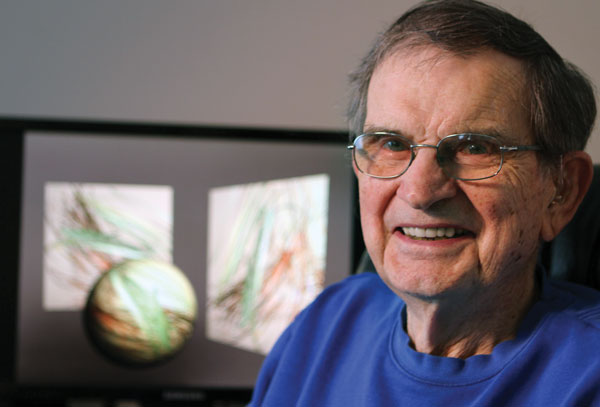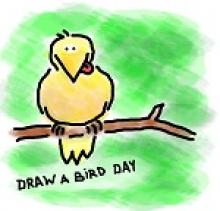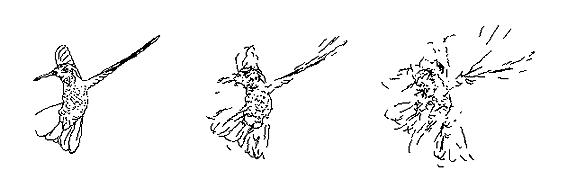Every year since 1943, people around the world have celebrated Draw A Bird Day (DABD) on April 8. Not an official government holiday, DABD began when a young girl visited her uncle, who was a wounded British soldier recovering in a hospital. When she visited, she asked him to draw a bird for her, which he did to her delight. The happy little girl, Dorie Cooper, visited her uncle and the other soldiers in his ward several times during his recovery, and many of the soldiers began drawing bird pictures for her and hanging them on the hospital walls.
It may seems strange to bring up DABD on a technology blog, but when I ran across this bit of trivia, it instantly reminded me of another bird drawing not quite so far back in history. In the early 1960s, Charles “Chuck” Csuri, a professor of art at The Ohio State University, began experimenting with computer graphics, creating computer animations of various subjects.
In 1967, Chuck had created one of his most recognized early pieces, “Sine Man,” a line drawing of a man that was manipulated by a sine curve mapping function on an IBM mainframe computer and printed on a plotter. Later that year, he and Ohio State colleague James Shaffer produced a ten-minute computer animated film titled Hummingbird. Chuck recalled:
“The subject was a line drawing of a hummingbird for which a sequence of movements appropriate to the bird were outlined. Over 30,000 images comprising some 25 motion sequences were generated by the computer. For these, selected sequences were used for the film. A microfilm plotter recorded the images directly to film. To facilitate control over the motion of some sequences, the programs were written to read all the controlling parameters from cards, one card for each frame. …”
While it’s doubtful that anyone today under the age of 25 would be impressed with the simple animation in Hummingbird, Chuck was a pioneer of computer animation, using computers in ways they’d never been used before.
With Hummingbird and other projects, Chuck “expanded his notion of object transformation to include the morphing of human faces and animals. Today, morphing is characterized by a seamless transition between forms. Csuri’s early fragmentation animations foreshadowed morphing technology. However, the artist, more interested in modern art than photographic realism, used the time-honored artistic relationship between form and abstraction to accomplish the seamless morphing transition between the forms.”
 Chuck, a decorated WWII veteran and graduate of Ohio State, later founded the Computer Graphics Research Group, which became the Advanced Computing Center for Art and Design within the Division of the Arts and Humanities in the College of Arts and Sciences at Ohio State. He also founded the Ohio Supercomputer Graphics Project at the Ohio Supercomputer Center (OSC) and cofounded Cranston/Csuri Productions, one of the world's first computer animation production companies.
Chuck, a decorated WWII veteran and graduate of Ohio State, later founded the Computer Graphics Research Group, which became the Advanced Computing Center for Art and Design within the Division of the Arts and Humanities in the College of Arts and Sciences at Ohio State. He also founded the Ohio Supercomputer Graphics Project at the Ohio Supercomputer Center (OSC) and cofounded Cranston/Csuri Productions, one of the world's first computer animation production companies.
In 2010, OSC deployed some specialized resources that leveraged the unique capabilities of the graphics processing units (GPUs), a component that for several years had been boosting the computer graphics speed of mobile phones, personal computers and game consoles. In recognition of Chuck’s contributions to OSC and the field of graphic arts, the center dubbed these GPUs and related software the Csuri Advanced GPU Environment.
The Smithsonian Magazine has recognized Chuck as the father of computer graphics, computer animation and digital fine art. The Museum of Modern Art and the Association for Computing Machinery Special Interest Group Graphics also honored him for his groundbreaking contributions to computer animation. And, he received the Governor's Award for the Arts for the best individual artist and Ohio State’s prestigious Sullivant Award, in acknowledgment of his lifetime achievements in the fields of digital art and computer animation. Examples of his artwork are displayed in prestigious museums and private collections around the world and have been featured in lectures, books, magazines, journals and television.
And his Hummingbird? In 1967, it won an award for animation at the fourth International Experimental Film Competition in Brussels, and, soon after, the Museum of Modern Art in New York purchased the film for its permanent collection as an example of early computer-animated art.
These days, Chuck continues to observe many of life’s little miracles – such as hummingbirds – and to leverage powerful technologies to aid in his creation of amazing digital art. Happy Draw A Bird Day, Chuck!




